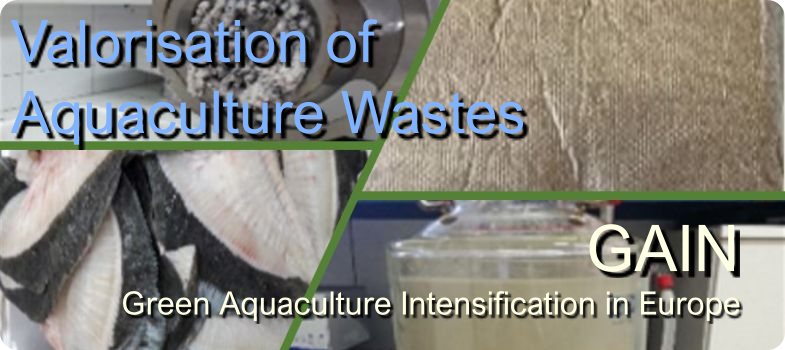Gelatins from skin aquaculture by-products
The skins that are generated in the peeling of the fillets of aquaculture species are a source of collagen material of great validity and commercial interest. These kinds of by-products are more and more abundant due to the eating habits of a large proportion of the population who prefer to eat clean fillets free of skin and bones.
In the GAIN project, several protocols have been studied in order to maximise the production of high-quality gelatins from skins of turbot, salmon, trout, sea bream and seabass. In a summary way, the stages involved are:
- Cut frozen skins into small portions to improve the effectiveness of the chemical treatments applied next.
- Water washing of the skins to eliminate impurities.
- The first step of chemical treatment with an alkalis solution for 30 min at room temperature using a solid: liquid ratio of 1:4 and maintaining gentle agitation.
- Second alkalis treatment at the same experimental conditions in order to improve the removing of non-collagen proteins present in the connective tissue and most of the fat contained in those fish farming species.
- A first acid treatment with sulfuric acid after another water washing to eliminate the remains of alkalis.
- A second acid wash with citric acid. Both acids treatments were performed in similar conditions of operation than alkalis one. The aim of these steps was to advance in the partial breakdown of the triple helix of collagen, the elimination of the fibrillar protein contained in the remains of muscle present in the skins, and to help in the cross-linking of collagen chains to avoid its complete degradation.
- Solid-liquid extraction of a gelatinous solution after the mixture of skins with water in a 1:2 ratio and thermal processing at 45ºC, under continuous agitation for at least 16 h.
- A purification-deodorization step using a combination of membrane filtration and adsorption by activated carbon.
- Final drying step using a convective oven (at 50-55ºC) or drum dryer equipment. A procedure of milling must be applied whether the product to be marketed is powdered gelatin.
The analytical techniques employed for the analytical characterisation of the fish gelatins are similar to those previously described for collagen. Additionally, the most important parameter to define the quality of gelatin is to determine the strength of gel producing from it. In this context, an aqueous solution of gelatin prepared at 6.7% (w/v) is cooled at 4ºC for at least 16 h and the bloom value of this gelatin is quantified in a texture analyzer.
